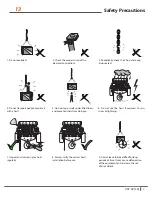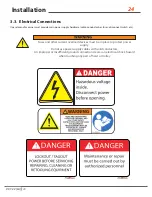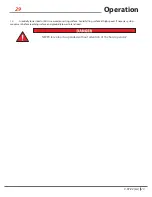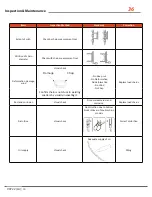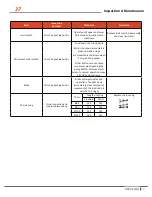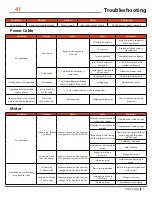
Version 1.0
27
Operation
27
4. OPERATION
4.2 Handling Precautions
4.1. Qualified Operator
Hoist operators are required to read and fully understand the operation section of this manual, all warnings contained in the
manual, and labels attached to the equipment.
Safe and efficient operation of this hoist requires an operator who displays caution and careful judgment. The operator must
be fully alert, focused, and aware of his/her surroundings. The operation of this equipment must be closely carried out under
the good practices defined by international and national safety standards, such as ANSI, OSHAS and ASME.
Training must be provided to the operator to ensure proper operation of equipment in compliance with the instructions
provided by this equipment manufacturer and the provisions of ASME B30. Equipment operation must be conducted under
the good practices defined by the applicable international and national safety standards, such as ANSI, OSHA, and ASME.
This hoist must not be operated by individuals who:
•
Cannot read, understand or speak language of security labels, ID Plate and User Manual of
•
equipment.
•
Does not meet legal age requirements.
•
Has visual or hearing impairments
•
Experiences mental, heart, or other health issues that could interfere with safe operation of
•
equipment.
•
Has not been fully trained on the use of hoist.
•
Has not received and read User Manual for exact equipment.
•
Has not demonstrated qualifications through a practical operation of hoist
ALWAYS:
•
Keep hoist in good condition and make sure chain is lubricated and free to operate.
•
Make sure electrical connection is grounded.
•
Make smooth movements; avoid sudden changes of direction.
•
Check the function of the hoist and trolley without a load before operation.
•
De-energize equipment after using it to avoid unintentional operation.
•
Keep everyone a distance of at least 1.5 times the length of chain. If load falls it can cause serious injuries and death.
•
Make sure no one is beneath the load.
NEVER:
•
Use pulleys or other accessories that are not specifically approved for the relevant hoist model.
•
Hoist load with the tip of the hook.
•
Hoist a load which is not vertical to the hook.
•
Use the hoist to pull or drag the load.
•
Exceed the maximum capacity of hoist.
V.07.22 [LA]
Summary of Contents for PWJTHF
Page 2: ...This page intentionally left blank...
Page 19: ...Version 1 0 19 Specifications 19 V 07 22 LA...
Page 20: ...Version 1 0 Specifications 20 20 V 07 22 LA...
Page 33: ...Version 1 0 33 Parts 33 1 4 Trolley assembly drawing V 07 22 LA...
Page 49: ...49 Wiring Diagram 49 7 CONVENTIONAL HOIST WIRING DIAGRAM PWJTHF PWJTHT V 07 22 LA...

